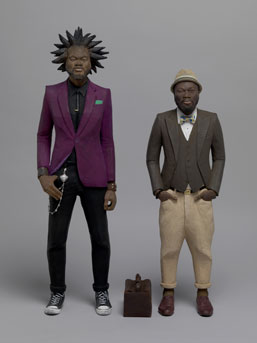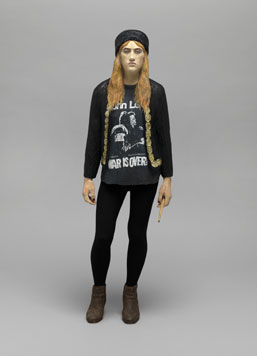Balancing Traditional With Trendy
It sounds like the start of a bad cracker joke for the hip London art set — what do you get if you cross transient urban fashion with a traditional Japanese wood carving technique? Tomoaki Suzuki’s sculptures (boom boom). But his work represents a serious trend -– the necessity that many YJAs feel of moving abroad to challenge and expand their creative horizons.
As many of his Japan-side contemporaries focus on works that engage with the phenomenological world using transient materials (Rei Naito, Aiko Miyanaga) Suzuki chooses to combine solid natural materials with his observations of street culture. His initial training in the technique of wood carving (as practiced by Hiragushi Denchu), was challenged by further study at Goldsmith’s where Suzuki had to hone his artistic vision.
Challenge is no bad thing, and, armed with a newly acquired conceptual dexterity, Suzuki transformed his work from a craft to an art. He has been featured in various U.K. publications including The Guardian newspaper and Timeout magazine, and in 2005 beat artists such as Mark Wallinger and Stephen Cox to win a competition to create a nativity scene for St-Martin-in-the-Fields Trafalgar Square space. The final design was a distinctly multi-racial set of shepherds and other Christmas regulars dressed in outfits by Jessica Ogden and was a critical and public success.
This show, his first solo show in Japan, fuses East/West skills and perceptions and relocates his reference points. No longer the outsider gazing in on a strange tribe, Suzuki represents them within a gallery known for its previous incarnation as a sento or Japanese bathouse.


The four exquisitely detailed figures give insight not only into the fashions of London’s creative set but into a generation aware of the fleeting nature of hype, grappling to balance tradition and throwaway trends. Created through taking photos of his subject in 360 degrees and painstakingly carving them, they are anything but throwaway. Often using his friends as models, the four featured figures (Joseph, Nena, Sam and Shaka) are new works created for this show.
These are portraits and their attention to detail (check out the John Lennon t-shirt, converse boots and lace-up brogues) gives them a realism which their size renders disturbing. At an average of 50cm viewers will tower over them, needing to bend down to look closely to catch the nonchalant gaze and the painted embroidery.Their ability to alter our perceptions of size and lifelike-ness has something in common with the sculptures of Ron Muek, but, unlike Muek, Suzuki’s is still working within the confines of tradition with a long history. It is precisely the contrast of technique within craft with an almost anthropological fascination with contemporary groups which makes the works so interesting. A small fish in a big pond Suzuki’s blending of these elements prove that this show will certainly be the continuation of an upward trajectory.
Rachel Carvosso
Rachel Carvosso



